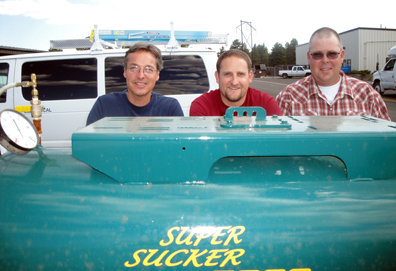The same french fries that are fueling Northern Arizona University students also are fueling NAU buses. Made from used vegetable oil collected from Dining Services, biodiesel is powering two shuttle buses in the latest “green” addition to campus.
Inspired by President John Haeger’s commitment for Northern Arizona University to reduce its carbon footprint, Chris Johnson, fleet manager of Transportation Services, introduced the idea of making biodiesel fuel about a year ago.
“When President Haeger said, ‘What can we do?’ I saw this opportunity to make biodiesel fuel like a low-hanging piece of fruit we had to grab,” Johnson explained.
Robert Chavez, director of Operations at Capital Assets and Services, Paul Capps, custodial manager, and Duane Lindquist, a driver for Transportation Services, agreed with Johnson and the four future biodiesel “brewmasters” began to research the ins and outs of making the fuel. They found many other universities running buses on biodiesel, but few making the fuel themselves or making it at a commercial level.
The team contacted Edgar Civitello, NAU associate professor of chemistry and biology, to test used vegetable oil collected from the University Union to determine if making biodiesel was viable at NAU. Civatello discovered that the oil was not only satisfactory, but high quality.
Research also revealed that challenges arise using biodiesel fuels in cold temperatures. The city of Flagstaff has trouble with its purchased biodiesel fuel freezing in the winter, largely because the buses are parked outside. This compelled the NAU team to try the fuel in two shuttle buses because they run virtually nonstop and are garaged at night at the transportation warehouse at Capital Assets.
“We tested about one quart of the 100 percent biodiesel that Edgar made in his lab last winter and put some of it outside one night,” Johnson explained. “It was about 19 degrees the following morning and it was solid. After bringing it back into the shop, in about 20 minutes it was fluid again. “
A flip of a coin led to the decision to run a 50/50 blend of the biodiesel combined with regular diesel. Many people use an 80/20 blend with only
20 percent made up of biodiesel—the City of Flagstaff buses run on a 5 percent blend. It’s possible that NAU might run a 100 percent blend in the future. It’s also likely that they will reduce the ratio of biodiesel to diesel for the winter months.
“I would be comfortable running the buses on 100 percent biodiesel oil,” Chavez said. “But at the moment, I think we are where we need to be. We can walk back here at any moment and make the stuff. In the future we would like to expand to collect more oil from the High Country Conference Center, too.”
|
After experimenting with cooking up small batches of biodiesel, the team members determined that a larger processor was needed—a piece of equipment that resembles a still—in order to make enough biodiesel to be useful. The processor was purchased with leftover funds in a local account. Chavez estimated the cost of the project at $20,000 and that included everything needed for the containment and processing of the oil, including the chemicals required.
The processor arrived in May and the four began their new duties as “brewmasters” and used vegetable oil collectors, obtaining the oil from the Union and du Bois Center.
Besides reducing the use of carbon, biodiesel has an additional perk. “The vegetable oil adds a lot of lubricity to the fuel and helps to clean the engine,” Johnson said.
The biodiesel experiment is ongoing but it appears to be a success. The biodiesel fuel is cheaper at about $1.67 a gallon, cleaner and a testament to what NAU employees can do to make the campus a better place.




